

Why Talviste Canyon... My design for this module was to be a canyon with a trestle bridge and a road bridge crossing the canyon. There was also to be a mountain in the background that would have a pass through tunnel that also had excape tracks for a hidden yard. (see image above)
The most essential thing was to make the module as light as possible. I used a light weight wood construction giving attention to structure over mass. I used sheet foam where ever I could. When it came to the rock work I did not want to use traditional plaster rocks so I went with Bragdon Enterprises Geofoam.
My friend Mike Talviste was of great help with the making and installation of the geofoam product that we used in forming the mountains and the canyon walls. My canyon needed a name and Mike had gaven up a number of evenings of his time plus the use of many of his rubber rock molds. Without his help what I would have ended up with, would be just blocks of Styrofoam covered with grass turf.
The mission
To build a module with a canyon and a trestle. An inside corner was the best choice for this because the tracks move into the center of the module and the length of the module allows for a large display and room for the trestle.
The club standard is for three tracks at: 2, 4, and 6 inches from the front edge at ether jointing end of the module. What they do in between is up to the module owner as long as they enter and exit at 2, 4 and 6.
Lines 1 and 2, (tracks at 2" and 4") where to cross the trestle. Line 3 (track at 6") was to pass through a tunnel. This is because I felt that a three track curved trestle would be just a little to ridicules. Splitting off line 3 into a hidden yard was just an add bonus the tunnel provided.
A roadway and road bridge was added to give it more caricature. And due to the mountain and canyon taking up by most of the scenery. I needed something to tie this rural scene to the surrounding urban areas.
The dimensions of the inside corner module where determined in a CAD program based on the existing dimension of the current outside corners and the club standard of 30" deep.
Because of the massive size of the module care was taken in the design of the bench work and the scenery materials. Weight would be of the utmost concern. The frame was glued and screwed. I used high-tech construction glue in all the joints so I would have no glue failures. High-strength plywood was used, with corner-cleats in every corner. The scenery material is Styrofoam and Geodesic Foam*
Well that was the plan now take a look at the results.
The Bridges…
There are two bridges a two track trestle bridge and the road bridge.
The trestle bridge has no name except Taviste Canon Trestle. The bridge is unique because it is a two track curved bridge. The trestle was hand crafted by me to fit the space all of the lumber was ripped to scale from scraps of alder wood. A jig was made to make the bents and they were cut to fit the canon. A curved board was sided to match the road deck and the bents where assembled to match this board.
Talviste Canyon.
This web page is about the history and evolution of my first road ready HO scale modular display. It is an inside-corner module. That is to say it will allow for an inside curve display. This module was made in conjunction with a model train club I used to belong to. The club ran a traditional loop display. The goal of this module was enabled us to assemble an L shape display instead of the standard rectangular display. The module was used in a number of shows before I retired from the club and additionally the retirement of the module due to the fact it was built to the clubs unique standards.
I plan on converting the module to a more universal standard.
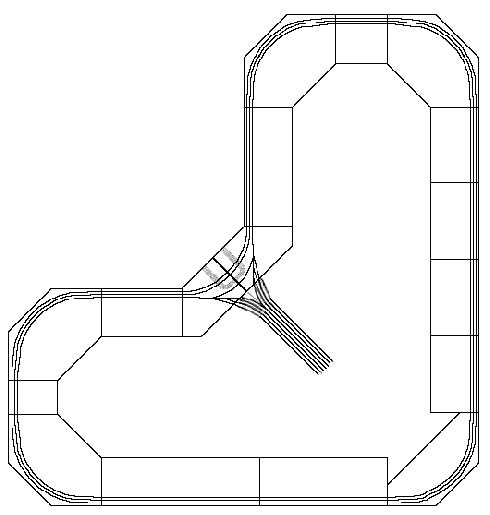
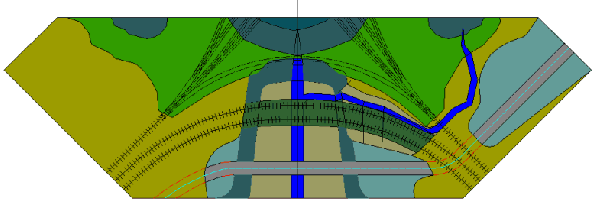
This is a top view of initial design of the inside corner from the face of the module looking backward. This is the closest design to the actual finished module. Due to constrictions of the final construction and the placement of the rock work the river and water falls have changed position.
This is based on the CAD drawings the trackage trestle and road bridge are roughly in the same place on the finished module though the length of the bridges are different.
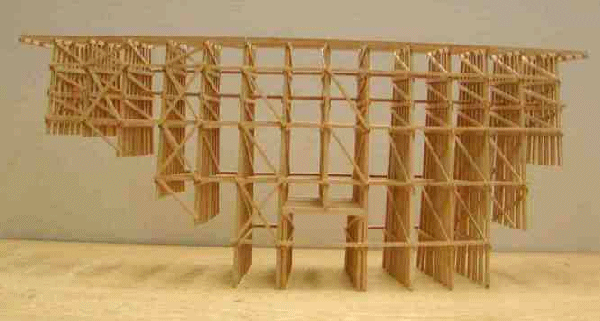
Angel Bridge
Unlike the trestle bridge the road bridge does have a name. Angel bridge was constructed from Rix road bridge deck and railing and the base was hand made from MDF wood and embellished with decorative buttons. I painted it with concrete color craft paint and weathered with pastel chalk. The bridge got its name from the angel button I placed in the center of the bridge.
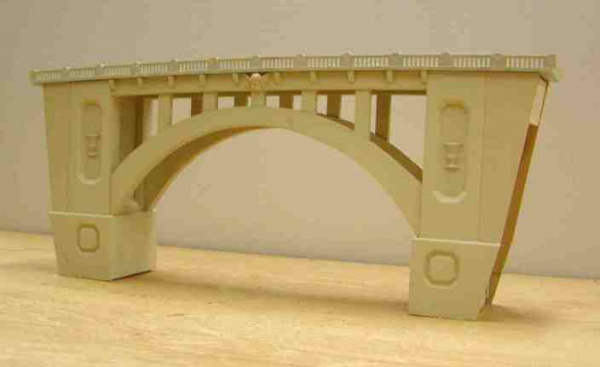
The module
The construction of the module. The bench work is a traditional box frame with a plywood and homasote deck. Sheet foam is used in areas where structure from wood was not needed. The real difference is 1/2 plywood was used for the main structure and 3/4" was used in key areas where strength was needed. I used multilayer birch plywood. Ever joint was glued and screwed. It is strong and light.
I don't have any images of the bench work so well begin with the rockwork.
This first image shows the hard shell which forms the base of the mountain. The hard shell is based on the Bragdon Enterprises method. You can see the tracks leading into the tunnel.
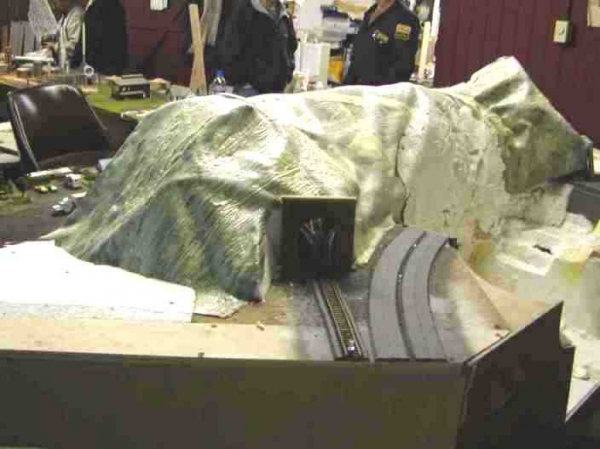
In this image rock work is being applied. One of the benefits of using Geodesic Foam products is, it is still flexible when you remove it from the molds you can apply it directly to the hard shell allowing it to form fit. It can also be easily cut with scissors. The best part is you don't have to wait for the rockwork to dry before you can paint or work on surrounding scenery.
More rockwork has been applied and the bridges are being fitted. The auto tunnel is ruffed out.
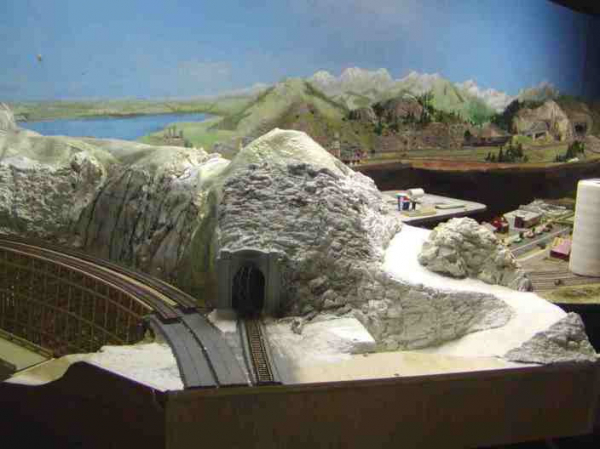
The right side of the module.
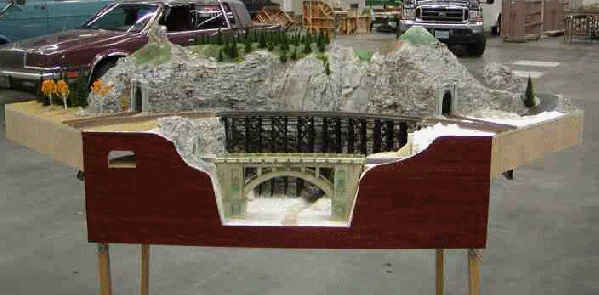

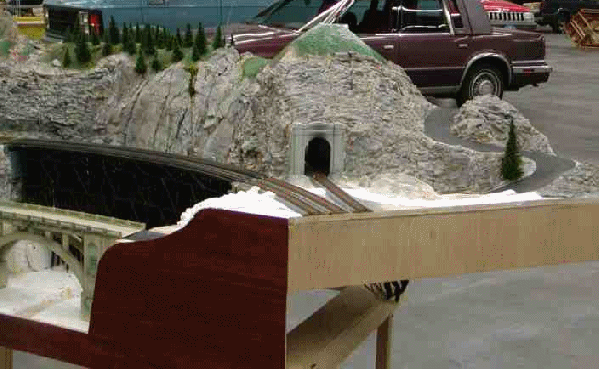
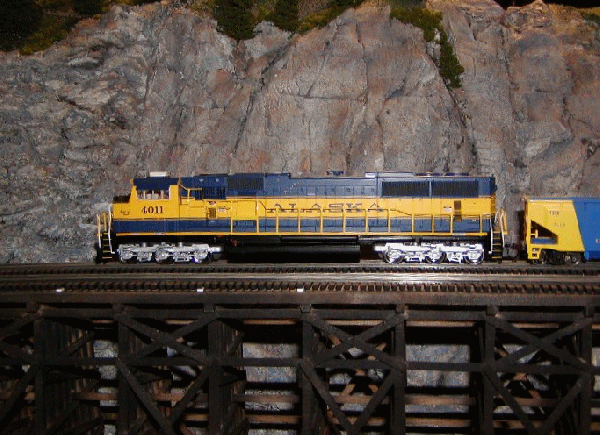
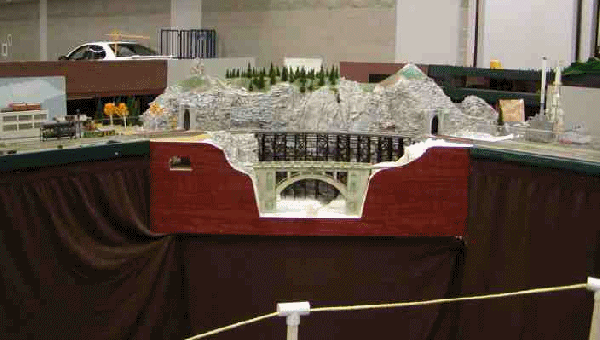
The Modules first Show
Here is a look at the near finished module ready for its first showing at the Great American Train Show.
Installed and ready for trains.
The first trains to cross the trestle.
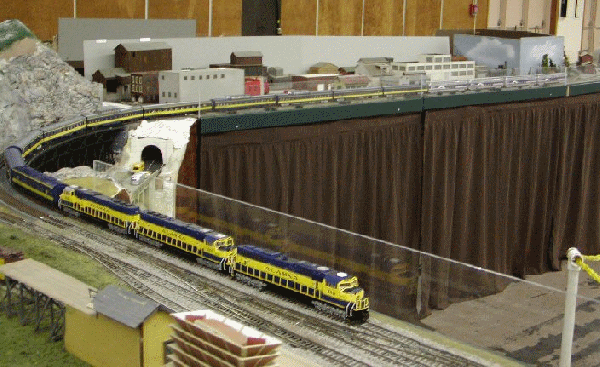
Extras
A special look at the backside.

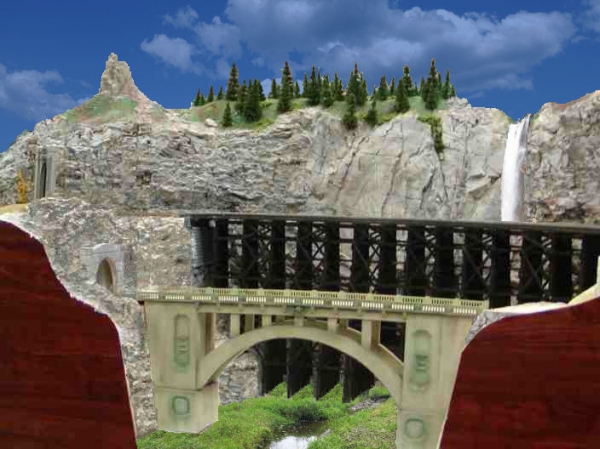
This is how I imagined how the module would look like if and when I ever finish it. The waterfall, river and grassy valley floor are digitally added and so is the sky.
